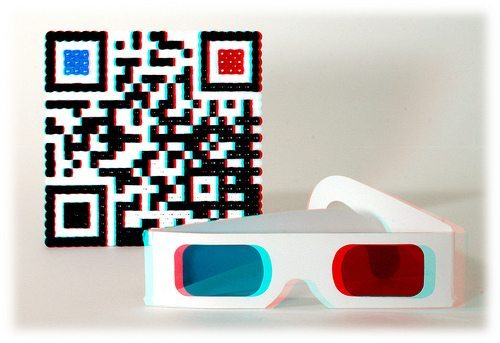
This article was originally published at display-central.com.
Quick Response (QR) codes — the box-shaped symbols that appear on signs, posters, and even business cards — are a convenient and efficient way of accessing specific web pages with a smartphone or other mobile device. However, new research published today in The Optical Society’s (OSA) new high-impact journal Optica, explains how QR codes can do much more.
By adding an array of tiny lenses to an ordinary smartphone, a team of optical engineers from the University of Connecticut has found a way to securely display three-dimensional (3-D) images by simply scanning a series of QR codes — without ever accessing the Internet. This data storage and display scheme could have exciting implications for personal 3-D entertainment, product visualizations for manufacturing and marketing, and secure 3-D data storage and transmission.
“We have developed a method of using QR codes along with off-the-shelf mobile device technology such as smartphones to enable encrypted 3-D information to be securely displayed on mobile devices,” said Bahram Javidi, the project team leader and co-author on the paper. “The QR codes we developed store compressed and encrypted images, which can be easily scanned, decrypted, and decompressed by commercial smartphones for secure 3-D visual communication.”
Harnessing the Potential of QR Codes
Through their research, the engineers also addressed an intrinsic security flaw with QR codes. Currently, if a link to a website is stored in the QR code, a smartphone will automatically link to that website and access the data stored there, but that website may contain malicious programming. “In our proposed method,” Javidi said, “we store self-contained slices of data in the QR codes themselves. It’s then possible to receive and visualize 3-D images without using the Internet.”
The process of storing and encoding the images is done by first selecting the primary image to be visualized. This could be either a single 3-D object, like a car or household object, or an entire 3-D scene.
The 3-D image is then broken down by taking multiple 2-D images of it from multiple perspectives — each 2-D image is known as a single “elemental image.” Each elemental image is taken from one portion of a precisely oriented array of tiny lenses called ‘lenslets’.
The lenslet array, which resembles the multifaceted surface of a fly’s eye, captures the scene from many slightly offset perspectives in a process known as “integral imaging.” Each elemental image is then split into two essential parts: the angular information (the unique perspective of the 3-D scene) and the corresponding intensity information, which establishes the shades of gray in each pixel.
If this information were simply recorded digitally, the process could easily be reversed by back-projecting all the elemental images through identically arranged lenslets and then overlapping and superimposing them to form a 3-D image.
Encryption for Secure Image Display
In this case, however, each elemental image goes through a program that compresses, encrypts, and stores that information as a QR code. A smartphone with any commercial QR reader can then retrieve that data by sequentially scanning multiple codes.
A separate decryption app with a unique security key would be needed to decompress and reconstruct the image and only a smartphone with the correct key would be able to access the data.
For the purpose of this research, the data was exported to an external computer where a specialized program decompressed and decrypted the image.
Once all of the QR codes are converted back to the elemental images, the 3-D image is reconstructed and displayed by placing a lenslet array on top of the smartphone screen.
“No special QR code reader or technology is needed,” said Javidi. “However, we do not yet have an app to decrypt and decompress the image stored in the QR code, but it can be easily developed.”
The researchers believe this is a highly secure method for data transfer. For the purpose of the demonstration, the researchers used a process known as double-random-phase encryption, which has been used successfully in other applications. In this case, it is coupled with “photon counting,” which is an imaging scheme that uses very sparse visual information and then transforms it mathematically to significantly improve the security of the process.
Next Steps and Bringing 3-D Capabilities to Smartphones
This system is still in the concept stage and not yet available for commercial use. In looking toward future applications, however, the researchers believe that their system can be improved to produce higher quality 3-D visual images and a more secure integration with smartphone technology.
“This is definitely something you can look forward to accessing on your smartphone. We have successfully shown how QR codes can be a means to display 3-D images and secure visual communication,” said Javidi.
Paper: A. Markman, J. Wang, B. Javidi, “3D Integral Imaging Displays Using a QR Encoded Elemental Image Array,” Optica, 1, 5, 332-335 (2014).
doi: http://dx.doi.org/10.1364/OPTICA.1.000332

